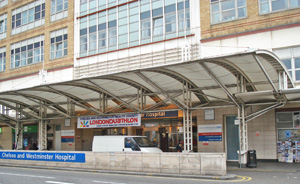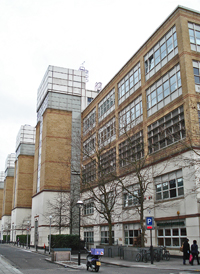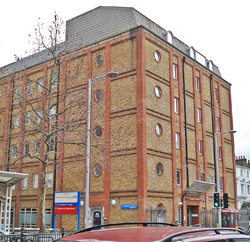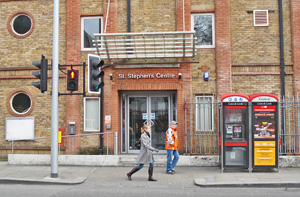St Stephen's Hospital
369 Fulham Road, Chelsea, SW10 9TH
Medical dates:
Medical character:
1876 - 1989
Acute
In 1876 the St George's Union purchased 2.5 acres of
land from a neighbouring priory, adjacent to its workhouse in Fulham
Road. This enabled the workhouse to be extended and a separate
infirmary to be built alongside.
The Infirmary opened on 20th February 1878, having cost £85,000. The
Fulham Road frontage was 160 ft (48.6 metres) in length and had two
entrances - one to the administration
block on the more western side and the other to the ward blocks.
The administration block contained offices and committee rooms, a dining hall, kitchens, stores, nurses' accommodation and a dispensary. Additional buildings included receiving wards, a new residence for the House Surgeon, a chapel which could seat 600, wash-houses and a steam laundry, and extra accommodation for inmates.
The seven 4-storey pavilion ward blocks were linked by a single-storey corridor running along their entire western side (a corridor on the eastern side connected them to the chapel). Each block had a 28-bed ward on each floor, making a complement of 800 beds - the largest infirmary in London at that time. In addition, each floor contained nurses' rooms, WCs and other amenities.
As well as the workhouse inmates, patients from the local area were also admitted.
In 1899 a Nurses' Home was built and, later, isolation blocks and a mortuary.
In 1913 St George's Union merged with the adjacent Strand and Westminster Unions to become the City of Westminster Union. The Infirmary was renamed the Fulham Road Infirmary.
In 1918 a Venereal Disease (V.D.) Department opened due to the increasing number of patients.
In 1920 an operating theatre was installed.
In 1924 a proposal to change the name of the Infirmary to the City of Westminster Hospital was challenged by the Westminster Hospital, which felt it would lead to confusion. In 1925 the Board of Guardians of the Union agreed that this would be the case and decided to use the name St Stephen's Hospital instead.
Following the abolition of the Boards of Guardians in 1929, on 1st April 1930, the LCC took over the workhouse and the Hospital. The workhouse was renamed a Public Assistance Institution, while the Hospital became a municipal hospital.
However, despite containing 796 beds, it was seriously under-equipped for a role as a general hospital. It lacked Out-Patients and Casualty Departments and had no X-ray Department.
In 1934 plans were made to establish X-ray and Massage (Physiotherapy) Departments and to build a Casualty Department. The work was completed in 1937. A Nurses' Home was also built, which contained only 2 baths, 2 WCs and 2 washbasins for 16 nurses.
At the outbreak of WW2 in 1939 the Hospital joined the Emergency Medical Service. During the war, it sustained bomb damage in 1940 and 1941, two ward blocks being destroyed beyond repair and the others significantly damaged. Patients from the most severely damaged wards were transferred to other hospitals but, despite the loss of life of both patients and nursing staff, the Hospital remained open for the duration of the war.
The workhouse accommodation was converted into accommodation for European refugees who had fled from the war.
In 1948 the Hospital joined the NHS under the control of the Chelsea
and Kensington Hospital Management Committee, part of the South West
Metropolitan Regional Hospital Board.
In 1951 the Hospital had 450 beds.
New operating theatres were built in 1952, replacing one of the two
bomb-damaged Victorian ward blocks. The operating suite, which
had cost £39,000, was opened in October 1952 by Iain McLeod, the
Minister of Health. The small Out-Patients Department and the
Physiotherapy and Occupational Therapy Departments were extended.
A Medical Records Office was organised.
By 1953 the nursing staff numbered 261 (presumably many were
part-time). There were 501 beds (of which 445 were in use, with a
bed occupancy of 86%). However, the sanitary annexes in the wards
were primitive, with two WCs, 1 bath and an open sink with a jet for
washing bedpans. The beds in the Physical Medicine Ward were set
close together; the ward was crude with little privacy. The
Hospital also had Rheumatic Wards, with beds for 18 females and 20
males. There was also a Children's Ward. The Pathology
Laboratory was located in part of the workhouse buildings, but the
X-ray Department was modern and adequate.
In the 1960s the site of the workhouse buildings (which had become
a hostel) was redeveloped; a new 3-storey Out-Patients Department
and Accident & Emergency Department opened in 1965. Later, in 1971, a new ward block was added.
Following a major reorganisation of the NHS in 1974 the Hospital came
under the administration of the South (Teaching) District Health
Authority, part of the South West Thames Regional Health Authority.
In 1982, after another major reorganisation of the NHS, the Hospital joined the Riverside District Health Authority.
The Hospital closed in 1989 and was demolished.
| Present status (February 2008) The new Chelsea and Westminster Hospital, with 580 beds, was built on the site. It opened in 1993. The only part of the original Hospital to survive is the adjoining Kobler Centre, later renamed St Stephen's Centre, for the treatment of HIV/AIDS, which was opened by Diana, Princess of Wales in 1988, a year before the Hospital closed. An IAVI laboratory for the development of an AIDS vaccine opened here in 2001. |
|---|

The Chelsea & Westminster Hospital was built on the site of St Stephen's Hospital.

The main entrance in Fulham Road.

The eastern elevation.

St Stephen's Centre is the largest HIV unit in Europe.

The entrance to St Stephen's Centre.
References (Accessed 28th December 2015)
http://blitzwalkers.blogspot.co.uk
http://collage.cityoflondon.gov.uk
https://rbkclocalstudies.wordpress.com
www.flickr.com (1)
www.flickr.com (2)